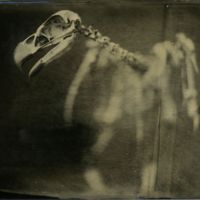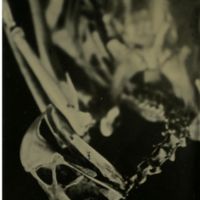Wet Plate Collodion
The Wet Plate Collodion process began in the 1850s. Unlike the other processes mentioned, this process entails making a photograph, rather than exposing an existing negative of a photograph onto a sensitized surface.
Bromide, iodide or chloride is dissolved in a mixture of collodion and ether. The mixture is poured onto a plate and then placed in a silver nitrate solution before exposure of the plate. The photograph must be taken with 15 minutes of the plate coating, making this process rather difficult to photograph certain subjects. The exposure actually creates a negative image, however paints are often painted black, which cuases the image to appear positive.
A collodion image made on a tin plate is termed a tintype, while a collodion image on a glass plate is called an ambrotype. Ambrotypes are backed with a black material in order to read the image as a positive. If exposed onto a clear plate of glass, a glass negative could be made.



